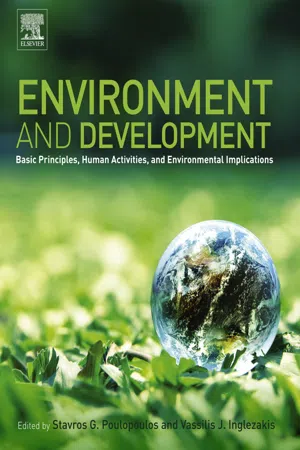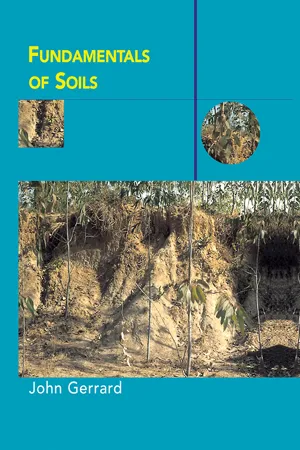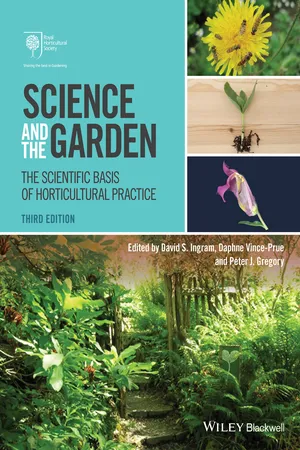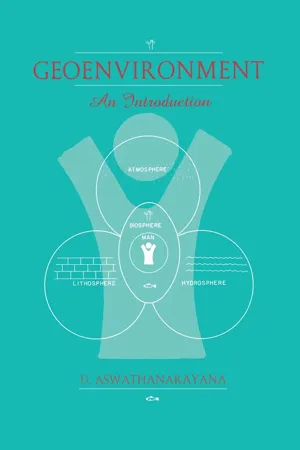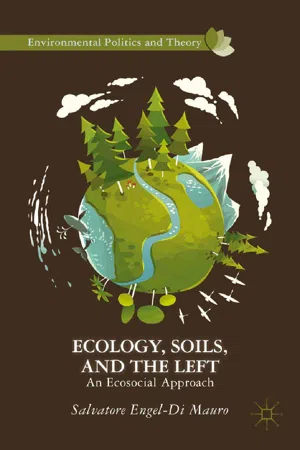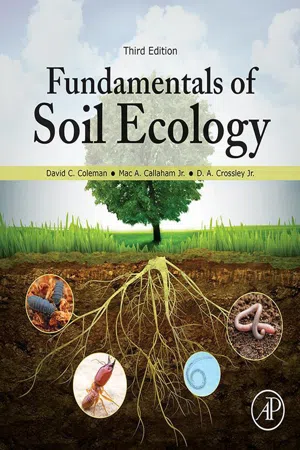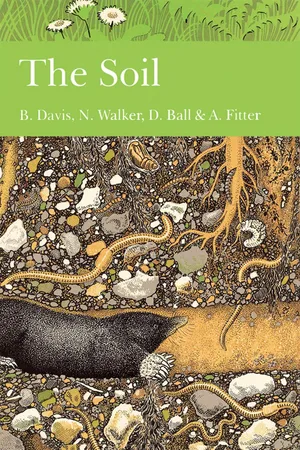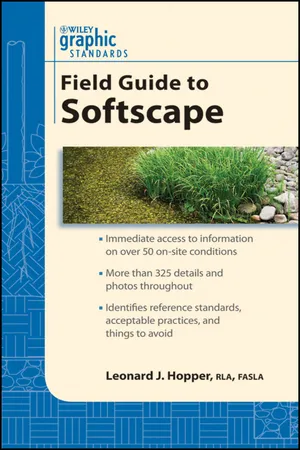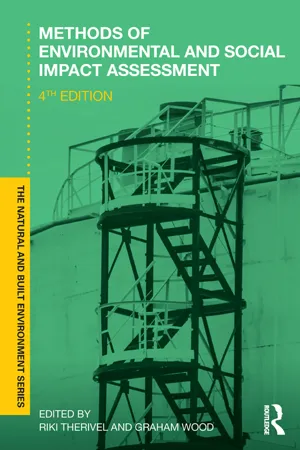Geography
Soils
Soils are the uppermost layer of the Earth's crust that support plant growth and provide a habitat for various organisms. They are formed through the weathering of rocks and the accumulation of organic matter. Soils vary in composition, texture, and fertility, and play a crucial role in shaping landscapes and influencing human activities such as agriculture and construction.
Written by Perlego with AI-assistance
Related key terms
10 Key excerpts on "Soils"
- eBook - ePub
Environment and Development
Basic Principles, Human Activities, and Environmental Implications
- Stavros G. Poulopoulos, Vassilis J. Inglezakis(Authors)
- 2016(Publication Date)
- Elsevier(Publisher)
4.1. Introduction: Basic Definitions
4.1.1. Soil: The Skin of the Earth
Soil is generally defined as the top layer of the earth's crust, formed by mineral particles, organic matter, water, air, and living organisms. It is the interface between earth, air, and water and hosts most of the biosphere [1] . Soil, however, is not merely the sum of these constituents, but a product of their interactions. Soil is an extremely complex and variable medium; a typical sample of mineral soil comprises 45% minerals, 25% water, 25% air, and 5% organic matter; however, these proportions may vary [2] .Weathering is the driving process of soil development and describes the means by which soil, rocks, and minerals are changed by physical and chemical processes into other soil components. Therefore, weathering is an integral part of soil development. Depending on the soil-forming factors in an area, weathering may proceed rapidly over a decade or slowly over millions of years. Because it develops over very long timescales, soil can be considered a nonrenewable natural resource.Soil formation is a dynamic rather than a static process [3] while five major factors influence the kinds of soil that develop. Wherever these five factors have been the same on the landscape, the soil will be the same. However, if one or more of the factors differ, the Soils will be different. The factors are [4] :• Climate (mainly temperature and precipitation). Climate determines the nature of the weathering that occurs. Temperature and precipitation, for example, affect the rates of physical, chemical, and biological processes that define the profile development.• Living organisms. Native vegetation, microbes, soil animals, and human beings are factors that influence organic matter accumulation, profile mixing, nutrient cycling, and soil structural stability.• Nature of parent material. Geological processes have brought to the Earth's surface numerous parent materials in which Soils form. The nature of parent materials influence mainly soil texture1 - eBook - ePub
- John Gerrard(Author)
- 2014(Publication Date)
- Routledge(Publisher)
1 The Nature of Soil What is Soil?There are many different opinions as to what constitutes soil, and there is no commonly agreed definition. Soil is the superficial covering of most of the land area of the Earth and varies in thickness from a few millimetres to many metres. One definition is that soil is weathered material at the Earths surface which may or may not contain organic matter and often also contains air and water. A more all-embracing definition is that soil is a natural body composed of minerals, organic compounds, living organisms, air and water in interactive combinations produced by physical, chemical and biological processes. This would be a genetic soil definition. The primary components of soil are inorganic materials, mostly produced by the weathering of bedrock or other parent material, various forms of organic matter, gas and water required by plants and soil organisms, and soluble nutrients used by plants. These constituents differ from the parent material in their morphology, physical, chemical and mineralogical properties, and their biological characteristics.There is often confusion with the term regolith. According to Bates and Jackson (1987), ‘regolith’ is the layer or mantle of fragmented and unconsolidated rock material, whether residual or transported and of highly varied character, that nearly everywhere forms the surface of the land and overlies or covers the bedrock. It includes rock debris of all kinds, volcanic ash, glacial drift, alluvium, loess and other aeolian deposits, vegetal accumulations, and soil. Oilier and Pain (1996) use ‘regolith’ as a composite term for a variety of earth materials that may be closely related. These materials are weathered rock, which, if it is in place, is called saprolite, residuum, which is weathered material that has been disturbed and moved, transported surficial sediments, chemical products in the nearsurface environment, Soils, and miscellaneous products - eBook - ePub
Science and the Garden
The Scientific Basis of Horticultural Practice
- David S. Ingram, Daphne Vince-Prue, Peter J. Gregory, David S. Ingram, Daphne Vince-Prue, Peter J. Gregory(Authors)
- 2015(Publication Date)
- Wiley-Blackwell(Publisher)
The end result of all these interacting factors is to produce Soils of almost infinite variety. Even in gardens of fairly modest size there are likely to be areas noticeably different from one another that need to be managed individually if the best results are to be obtained. In addition to the soil-forming factors is the special influence of one particular organism, humankind. Gardeners contribute in many ways to the formation of new Soils by altering the drainage, moving soil materials to create deeper Soils, adding waste products such as manure to promote biological activity, and adding fertilisers and manures to improve the nutrient status. Less well appreciated are the off-site effects of human activities that also have an effect on the development of Soils. For example, industry and the burning of fossil fuels result in the Soils of most of Europe and North America receiving inputs of nitrogen (N) and heavy metals from the air. In southern England, the average input of N is about 25 kg per hectare per year; this is equivalent to applying 36 g (a large spoonful) of Growmore (an inorganic compound fertiliser formulated during World War II) to a square metre. Similarly, the cadmium content of the topsoil at the research institute at Rothamsted, Harpenden, Hertfordshire has increased by 40% since 1850. These and other industrial inputs to Soils will have significant consequences if they continue unabated.In simple terms, Soils are made up of mineral matter and organic matter, with the spaces between these solid materials filled with either water or air. The organisms live on the surfaces of the solid material and in the spaces. Soils, then, are complex media that have physical, chemical and biological properties. The aim of gardeners must be to manage these to the best advantage of plants. To achieve this effectively demands some understanding of the properties of the individual soil components and how they interact with each other.Physical properties of Soils
Soils are frequently defined in terms of their texture . This is a summary term describing the relative quantities of mineral particles of less than 2 mm diameter. Particles larger than 2 mm in diameter are usually referred to as stones, gravel or pebbles, and have no part in the description. The distribution of particles less than 2 mm in diameter cannot easily be altered, and influences many other important soil properties such as aeration, water-holding characteristics and ease of cultivation. This explains why this method of definition is so widely used; it is a stable, shorthand description of a range of properties.For convenience, Soils are allocated to a textural class depending on their content of sand, silt and clay-sized particles. Sand-sized particles are typically 0.05–2 mm diameter, silt particles are 0.002–0.05 mm, and clay particles are less than 0.002 mm in diameter. With a little practice it is possible to determine the textural class by rubbing a small ball of moist soil between the fingers and thumb (see Fig. 6.1 - eBook - ePub
- U. Aswathanarayna(Author)
- 2018(Publication Date)
- Routledge(Publisher)
CHAPTER 3 Environment of Soils The importance of the soil arises from the following considerations: (1) Soil is a natural resource, necessary for plant growth, (2) Erosion of the soil leads to environmental degradation and therefore needs to be controlled, (3) Soil is a source of the sediment, (4) Soil acts as a filter for the groundwater, and (5) Soil serves as a bearing material for roads, pipelines, buildings, etc., and as construction material for mud-built houses. In the ultimate analysis, man derives all the nutrient elements from the soil. However, he does not get them by eating the soil, but by eating the plant that grows in the soil, or by eating the meat of the goat that eats the plant. Whatever might be the technological advances, soil will always be necessary for man to grow food, fodder and fibre. To some extent, man also needs soil for habitation. Soil is both a resource which has to be used wisely to grow food, and also an environmental medium which has to be monitored to prevent the adverse impact of man. The adverse impact may manifest itself in the form of soil erosion, loss of soil fertility, salinisation and desertification, and the pollution of soil. Polluted soil contaminates the water and biota, and the pollutant ends up in the food chain. It should, however, not be forgotten that man also has a beneficial impact on the soil through drainage, fertilization and irrigation, which have improved many Soils which were not initially capable of supporting the growth of crops. Thus, an environmentally-benign management of the soil has two objectives: to support sustainable agriculture and to prevent soil pollution. 3.1 FORMATION OF SOIL Soils are the loose mantle on the surface of the earth. They may be formed in situ from rocks or sediments, or they may be deposited after transport. A soil is composed of mineral matter, living or dead organic materials, water and air. The components of the soil range in size from colloids to small particles - eBook - ePub
Ecology, Soils, and the Left
An Ecosocial Approach
- Kenneth A. Loparo(Author)
- 2014(Publication Date)
- Palgrave Macmillan(Publisher)
3 (Gobat, Aragno, and Matthey 2004, 65). This last aspect could be used to ascertain the distinction from sediments, but this may not be workable in the case of subaqueous Soils, for example (Demas and Rabenhorst 1999).The range of sometimes contrasting definitions reflects the difficulty of identifying Soils. As admitted by the Soil Survey Staff of the United States Department of Agriculture (USDA), “In some places the separation between soil and nonsoil is so gradual that clear distinctions cannot be made” (Soil Survey Staff 2006, 1). Besides omitting the existence of debate on this matter, the USDA staff might be underestimating the frequency of such murkiness. Figure 2.1a–c shows three cases to illustrate the point. Picture (a) is from Oakland’s Estuary Park (California, USA), displaying pickleweed (Salicornia spp.) at low tide and growing at the brackish water’s edge. During high tide, such succulent salt-tolerant plants are usually submerged in part or entirely. Picture (b) shows a pit dug on cultivated land, exposing a soil profile in Rádfalva (Baranya County, Hungary). Picture (c) shows several deciduous trees living on conglomerate sandstone on the lower-lying eastern portion of the Shawangunk Ridge (New York State, USA).Figure 2.1a A selection of Soils in different environmentsFigure 2.1b (Continued)In one way or another, all of the illustrations can be considered Soils, depending on interpretation. The first example might seem surprising, but since at least the 1970s, there has been official recognition of submerged (hydric or wetland) Soils, mainly in terrestrial and coastal wetlands (Kirk 2004; Mausbach and Barker 2001, 20). Soils have even been argued to develop under shallow seawater (less than 2.5m at low tide), in estuaries and coastal marine environments. This is because those Soils show distinct layers forming through variants of the basic soil-forming processes described on land. Bottom-dwelling organisms like seagrass not only anchor themselves on underwater sediments but also actively shape the characteristics of the sediment on which they settle. By so doing, they lead to the formation of layers with heterogeneous attributes, like carbonate enrichment, the formation of humus (highly decomposed organic material), and the movement and modification of elements like iron and sulfur (Bradley and Stolt 2003; Demas and Rabenhorst 2001).4 - eBook - ePub
- Graham Stirling, Helen Hayden, Tony Pattison, Marcelle Stirling(Authors)
- 2016(Publication Date)
- CSIRO PUBLISHING(Publisher)
Chapter 2
Soil physical, chemical and biological properties, and the key role of organic matter in promoting soil and plant health
Soils are not a uniform entity. They are formed from various types of rock and are weathered by different processes. Consequently, they possess a range of properties and are subject to quite different constraints. If farm managers are to minimise soil loss and degradation and maintain soil health in the long term, they must recognise that every soil is different, and develop management practices that are appropriate for the soil types on their farm. The introductory chapters of this book have been prepared with this goal in mind. They provide basic information on the characteristics and constraints that must be understood if soil is to be managed in a sustainable manner. This chapter provides a brief introduction to the mineral components of soil, and the physical, chemical and environmental factors that determine whether it is capable of supporting healthy, productive crops. The important role of the soil’s biological component is also mentioned, but the pests, pathogens and beneficial organisms that impact on crop production are covered in more detail in Chapters 3 and 4.Soil composition
Mineral particles are the most obvious component of soil, but air, water, organic matter and living organisms will also be present. The amount of each component varies with soil type and management but, in general, 45% of the soil is composed of mineral particles, 20–30% is air, 20–30% is water and 1–5% is living or dead organic matter (Fig. 2.1 ). The amount of air and water will change depending on how wet or dry the soil is, while the amount of organic matter varies with soil type, climate and the management system.Mineral particles
The mineral component of soil is made up of sand, silt and clay particles, sometimes referred to as the ‘primary soil particles’. These particles largely determine a soil’s physical characteristics and texture. Soils with predominantly clay particles are sometimes referred to as ‘heavy’ Soils, whereas Soils dominated by sand are considered to be ‘light-textured’. - eBook - ePub
- David C. Coleman, Mac A. Callaham, D. A. Crossley Jr.(Authors)
- 2017(Publication Date)
- Academic Press(Publisher)
Golley, 1993 ).In a concise review of almost a century’s work by pedologists and soil scientists, Johnson and Johnson (2010) offered the following passage with regard to a simple, overarching definition of soil in the broadest possible sense, which we endorse here as being perhaps the most succinct expression of these ideas to date:So, how should we define soil insofar as it technically is the 'skin' of landforms, an integument of planets, and in the case of Earth primarily biophysically-biochemically produced with an epidermal biomantle? The best scientific definition is one that is most useful and comprehensible to a spectrum of scientists and the lay public. It should be simply expressed, scientifically sound, easily explainable, and cover all cases (Johnson et al. 1997 ), and ideally have universality. Being applicable to soil on Earth and on all other generally lithic-composed planets and planetoids, a definition that fits these criteria is: Soil is substrate at or near the surface of Earth and similar bodies altered by biological, chemical, and/or physical agents and processes (emphasis added).In summary, all of these developments and advances in knowledge, from the ancient to the modern, have led to a vast literature upon which is based our current understanding of the soil beneath our feet and the vital role that this living milieu plays in sustaining life on a thin, dynamic, fragile planetary crust.1.3 Water as a Constituent of Soil
The occurrence of water is, moreover, not less important and hardly less general upon the land. In addition to lakes and streams, water is almost everywhere present in large quantities in the soil, retained there mainly by capillary action, and often at greater depths.(Henderson, 1913 ).Lawrence J. Henderson, a noted physical chemist and physiologist, published a book (The Fitness of the Environment - eBook - ePub
- B. N. K. Davis, N. Walker, D. F. Ball, Alastair Fitter(Authors)
- 2013(Publication Date)
- Collins(Publisher)
CHAPTER 2 THE VARIETY OF Soils IN BRITAINThe building blocks of the soil world have been described in chapter 1 as components that, assembled in differing frameworks of solid particles and intervening pores, are the basis of a complex physical environment. This complexity is exploited by a diverse range of soil organisms for living space, moisture and food. In this chapter, we draw back from considering the fine details of soil composition, and view the wide variety of soil types that contribute to the character of different regions and localities in Britain. Many books give comprehensive accounts of soil-forming factors, soil distribution, alternative classifications, and the application of soil science to land use and management issues, on world, national, and local scales. Here we give just an outline of one way of looking at the formation and variety of British Soils as a background to our main theme.The traditional ‘ecological’ approach to the field study of Soils is to consider vertical sections through this thin skin that covers most of the earth’s surface. These sections are three-dimensional units, that is to say, they have both a surface area and a depth. One particularly important contribution to this approach was that of W. L. Kubiena, in his book on The Soils of Europe, mentioned in chapter 1 .When seen in section, the character of a soil can change laterally, either abruptly or gradually, as soil-forming conditions change. Additionally, there are changes in soil properties and appearance as one moves downwards, from the ground surface with its plant cover, to the unchanged parent material below. This parent material may be solid rock, like limestone, or a relatively soft geological deposit, like London Clay, alluvium or wind-blown sand, or a man-made deposit such as colliery waste. - eBook - ePub
- Leonard J. Hopper(Author)
- 2011(Publication Date)
- Wiley(Publisher)
Chapter 1 Soils- Soil Overview
- Soil Assessment
- Designed Soil Mixes
Soil as a growing medium may be defined as a natural system, composed of mineral particles, organic matter, water, and air, all supporting growing plants. The “soil profile” consists of horizons, and there exist important interrelationships among the horizons, as they are interdependent and necessary for the entire profile to fulfill its function as a rooting medium, both in nature and in the designed landscape project (Craul and Craul 2006). The ideal soil has about 45 percent mineral solids, 5 percent organic matter solids, and 25 percent each water and air.Understanding the functional relationships within the general form of the natural soil profile (Craul 1992, 1999) is necessary to make a reasonable estimate of the degree of limitations present in the existing project soil materials, which is essential to formulating a soil design plan.Assessing Site ConditionsAs shown in Figure 1.1 , the major horizons of the ideal natural soil profile include:- O horizon (organic) —This horizon functions as a mulch that reduces evaporative water losses, lowers daytime and maintains nighttime surface soil temperatures, and contributes organic matter for soil tilth and acts as a source of energy for soil organisms.
- A horizon (topsoil) —This horizon contains incorporated organic matter and a large and diverse organism population, and serves as the major rooting medium for most of the plant roots.
- B horizon (subsoil) —This horizon provides added necessary rooting volume for plant stability and nutrient and water storage, to supplement the topsoil.
- C horizon (substratum or parent material) —The C horizon contributes deep rooting and drainage volume. It becomes more important to good plant growth in relatively shallow Soils.
- R horizon (bedrock)
- Peter Morris, Riki Therivel, Graham Wood, Riki Therivel, Graham Wood(Authors)
- 2017(Publication Date)
- Routledge(Publisher)
‘Solid’ maps show only pre-Quaternary rocks, and ‘drift’ maps also show superficial Quaternary deposits that have been laid down more recently after being moved by wind, water or ice. Lithology (the general physical characteristics of rocks) has a big influence on soil types through the mineralogical composition and texture of the weathered rock. However, because of the erosion, mixing and redistribution of surface rocks and weathered materials, drift maps tend to give the most informative indication of the soil parent materials in a survey area.Table 3.3Examples of geological maps and Digital Terrain Model (DTM) data sourcesCoverage Name Web link International One Geology Portal portal.onegeology.org US Geological Survey – Mineral Resources and Geology http://mrdata.usgs.gov/general/global.html ASTER Global Digital Elevation Map (DTM) https://asterweb.jpl.nasa.gov/gdem.asp Shuttle Radar Topography Mission (SRTM GL1) (DTM) https://catalog.data.gov/dataset/shuttle-radar-topography-mission-srtm-gl1-global-30m Australia Australian Geoscience Information Network www.geoscience.gov.au Canada Geological Survey of Canada www.nrcan.gc.ca/earth-sciences/science/geology/gsc/17100 India Geological Survey of India www.portal.gsi.gov.in South Africa Council for Geoscience (CGS) www.geoscience.org.za/index.php United Kingdom British Geological Survey www.bgs.ac.uk/data/maps/home.html Ordnance Survey OS Terrain 50 (DTM) www.ordnancesurvey.co.uk/business-and-government/products/terrain-50.html United States US Geological Survey www.usgs.gov Land and Soils
The starting point for the evaluation of land and Soils is to determine the usefulness of the information available. The scope and quality of existing data at the national and local scale can vary considerably. Published sources are not always directly applicable to new projects, but can indicate the land and soil likely to be found in a study area, and assist in planning field surveys (see §3.4.3
Learn about this page
Index pages curate the most relevant extracts from our library of academic textbooks. They’ve been created using an in-house natural language model (NLM), each adding context and meaning to key research topics.
